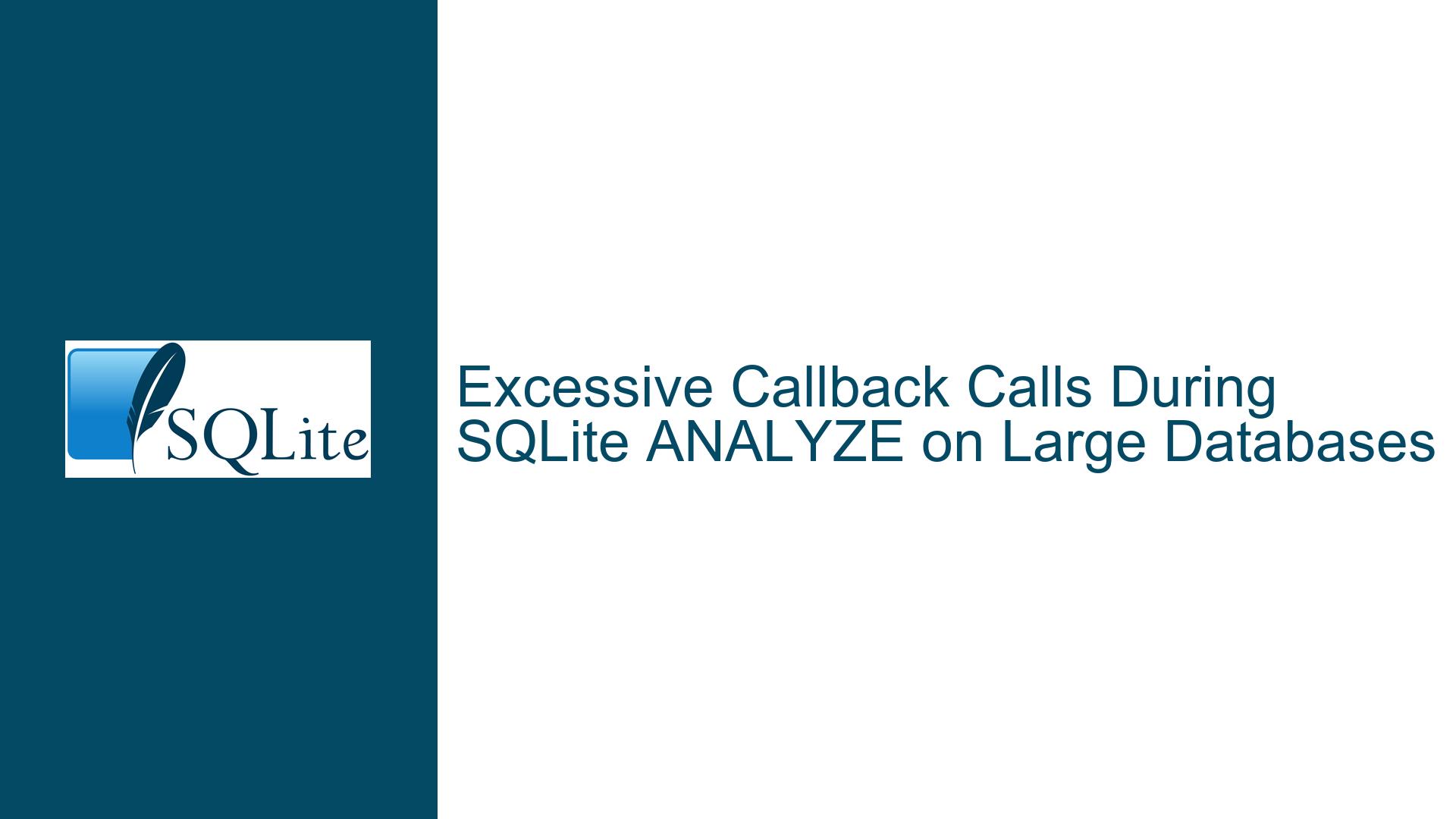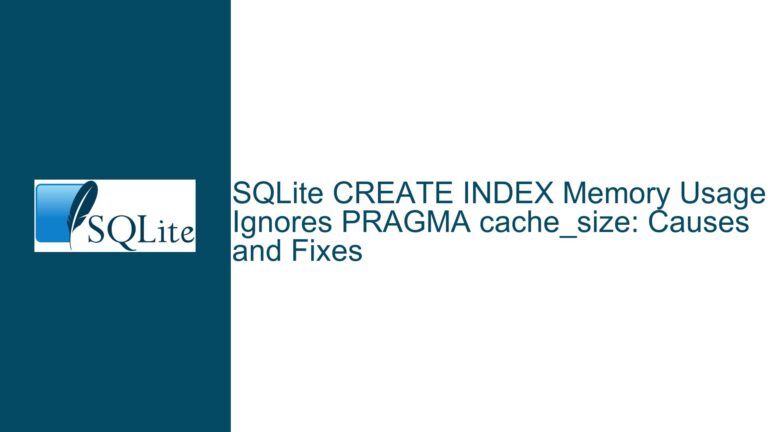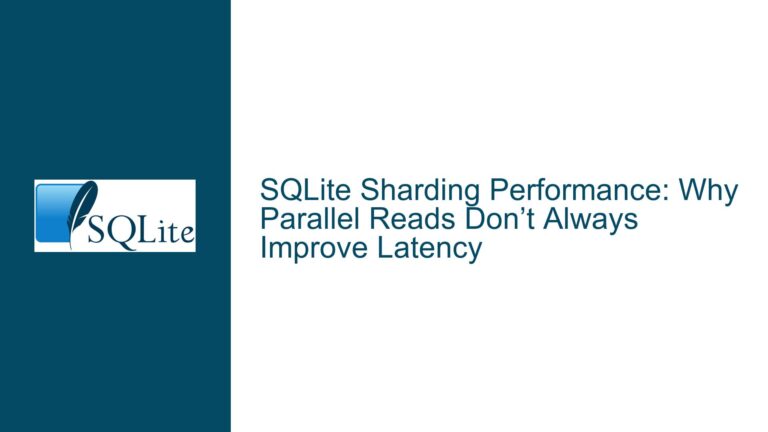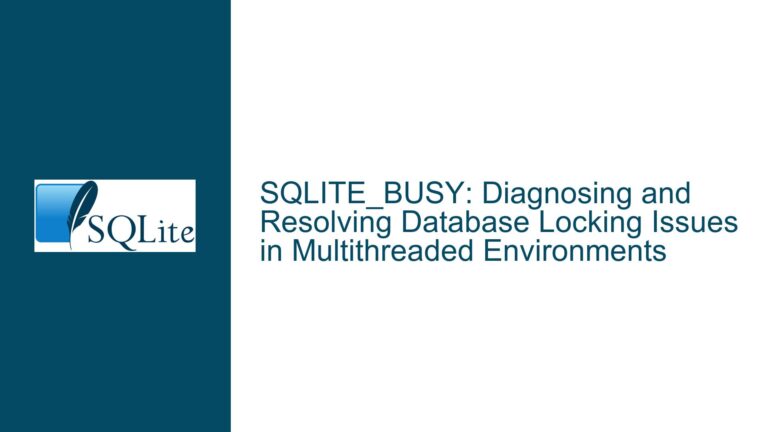Excessive Callback Calls During SQLite ANALYZE on Large Databases
Excessive Callback Invocations During ANALYZE Operation
When performing an ANALYZE operation on a large SQLite database, a significant issue can arise where a progress callback function is invoked an excessive number of times, leading to prolonged execution times. This issue is particularly pronounced when the database size exceeds 18 GB, and the callback is set using sqlite3_progress_handler(). Under normal circumstances, the callback is invoked a reasonable number of times (e.g., 28,000 times for a 20 GB database). However, in some cases, the callback can be invoked billions of times, causing the ANALYZE operation to take an inordinate amount of time or even appear to hang.
The ANALYZE command is used by SQLite to collect statistical information about the tables and indices in the database. This information is then used by the query planner to optimize query execution. The operation is generally efficient, with a time complexity of O(N), where N is the size of the database. However, when a progress callback is registered, the behavior can change dramatically, especially for certain databases that exhibit unusual characteristics.
The core issue lies in the interaction between the ANALYZE operation and the progress callback mechanism. The callback is intended to be invoked periodically to allow the application to monitor progress and potentially abort the operation if necessary. However, in some cases, the callback is invoked far more frequently than expected, leading to performance degradation. This behavior is not consistent across all databases, even those of similar size and schema, suggesting that the issue is influenced by specific database characteristics.
Potential Causes of Excessive Callback Invocations
Several factors could contribute to the excessive invocation of the progress callback during the ANALYZE operation. These factors include database schema complexity, index structure, data distribution, and potential issues with the callback function itself.
One possible cause is the presence of a large number of indices or complex indices in the database. The ANALYZE operation examines each index to gather statistical information, and if the indices are particularly large or complex, this could lead to an increased number of operations being performed, each potentially triggering the progress callback. Additionally, if the database contains a significant number of freelist pages or if the data is fragmented, this could also contribute to the increased number of operations and, consequently, callback invocations.
Another potential cause is the interaction between the callback function and the SQLite library’s internal mechanisms. If the callback function is not implemented correctly, it could inadvertently affect the behavior of the ANALYZE operation. For example, if the callback function modifies global state or performs operations that interfere with SQLite’s internal state, this could lead to unexpected behavior. Additionally, differences in calling conventions between the callback function and the SQLite library could cause issues, particularly if the callback function is compiled with a different calling convention than the SQLite library.
The issue could also be related to the specific characteristics of the database itself. For example, if the database contains a large number of tables or if the tables are particularly large, this could lead to an increased number of operations during the ANALYZE command. Additionally, if the database has undergone significant modifications or if it has been subject to corruption or other issues, this could also contribute to the problem.
Diagnosing and Resolving Excessive Callback Invocations
To diagnose and resolve the issue of excessive callback invocations during the ANALYZE operation, a systematic approach is required. This involves examining the database schema, analyzing the behavior of the callback function, and potentially modifying the way the ANALYZE operation is performed.
The first step is to examine the database schema and indices. This can be done using the sqlite3_analyzer tool, which provides detailed information about the database structure, including the number of tables, indices, and pages. By comparing the schema of the problematic database with that of a database that does not exhibit the issue, it may be possible to identify specific characteristics that contribute to the problem. For example, if the problematic database contains a large number of indices or if the indices are particularly complex, this could be a contributing factor.
The next step is to analyze the behavior of the callback function. This involves ensuring that the callback function is implemented correctly and does not inadvertently affect the behavior of the ANALYZE operation. The callback function should be as simple as possible, ideally doing nothing more than incrementing a counter. If the callback function performs any additional operations, these should be removed to determine if they are contributing to the issue. Additionally, the calling convention of the callback function should be verified to ensure that it matches the calling convention used by the SQLite library.
If the callback function is determined to be correct, the next step is to examine the behavior of the ANALYZE operation itself. This can be done by running the ANALYZE command with the .stats and .timer options enabled in the SQLite shell. This will provide detailed information about the number of virtual machine steps performed and the time taken for the operation. By comparing the output for the problematic database with that of a database that does not exhibit the issue, it may be possible to identify specific differences in behavior.
If the issue is determined to be related to the ANALYZE operation itself, one potential solution is to modify the way the operation is performed. For example, instead of running ANALYZE on the entire database, it may be possible to run it on specific tables or indices. This can be done using the ANALYZE table_name or ANALYZE index_name commands. By limiting the scope of the ANALYZE operation, it may be possible to reduce the number of callback invocations and improve performance.
Another potential solution is to use the PRAGMA quick_check command instead of PRAGMA integrity_check. The quick_check command performs a less comprehensive check of the database integrity, but it is faster and may be sufficient for many use cases. If the primary concern is to ensure that the database is not corrupted, quick_check may be a viable alternative.
Finally, if the issue is determined to be related to the specific characteristics of the database, it may be necessary to perform maintenance operations on the database. This could include running VACUUM to defragment the database and remove unused pages, or running REINDEX to rebuild indices. These operations can improve the overall performance of the database and may also reduce the number of callback invocations during the ANALYZE operation.
In conclusion, the issue of excessive callback invocations during the ANALYZE operation in SQLite is a complex one that can be influenced by a variety of factors. By systematically examining the database schema, analyzing the behavior of the callback function, and modifying the way the ANALYZE operation is performed, it is possible to diagnose and resolve the issue. While the specific solution will depend on the characteristics of the database and the application, the steps outlined above provide a comprehensive approach to addressing the problem.






